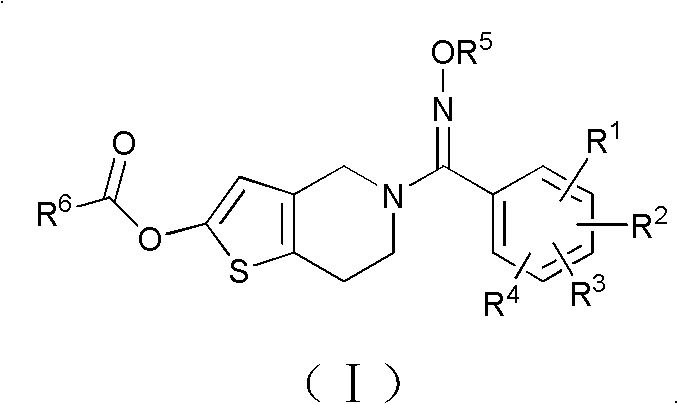Ester compound and preparation method and application thereof
A compound, C1-C4 technology, applied in the field of medicine, can solve the problems of patients with excessive bleeding and high bleeding risk, and achieve platelet aggregation inhibition and obvious effect of platelet aggregation
- Summary
- Abstract
- Description
- Claims
- Application Information
AI Technical Summary
Problems solved by technology
Method used
Image
Examples
Embodiment 2
[0059] Intermediate IV-1
[0060]
[0061] Add 13.9 g of intermediate III-1 to a reaction flask equipped with stirring, a condenser, and a thermometer, dissolve it with 40 mL of dichloromethane, and add 17.8 g of NBS while stirring. React under light at room temperature for 6 hours (the plate layer shows that the reaction is complete). with 3 x 30mL 35% Na 2 S 2 o 3 The reaction liquid was washed with aqueous solution, and the dichloromethane layer was fully dried with anhydrous sodium sulfate, filtered, and the dichloromethane was evaporated under reduced pressure to obtain a light yellow oily product (HPLC: 97.2%). Rf = 0.35 [single site, developing solvent: v (dichloromethane): v (methanol) = 6: 1]. 1 H NMR (DMSO-d 6 , 400MHz) δ: 2.324 (s, 1H, -OH), 7.572-7.961 (m, 4H, phenyl-H). Referring to the method of Reference Example 2, intermediates IV-2 to IV-7 can be synthesized.
[0062]
Embodiment 3
[0064] Intermediate V-1
[0065]
[0066] Add 2.2g of intermediate IV-1 into a reaction flask equipped with stirring, a condenser, and a thermometer, dissolve it with 10mL of anhydrous methanol, and add 2.76g of anhydrous potassium carbonate while stirring. 1.6 g of 5,6,7,7a-tetrahydrothieno[3,2-c]pyridin-2-(4H)-one was added to the reaction system in batches. After the addition was completed, the reaction was continued for 3.5h under reflux (the plate showed that the reaction was complete). Filter out the solid matter, evaporate anhydrous methanol to dryness, wash the reaction solution with 3×10 mL water, extract with dichloromethane, dry thoroughly with anhydrous sodium sulfate, filter, and evaporate dichloromethane under reduced pressure to obtain a black oil. Column separation [mobile phase: v (dichloromethane): v (methanol) = 9: 1], Rf = 0.45, gave a light yellow solid (HPLC: 99.3%). 1 H NMR (DMSO-d 6 , 400MHz) δ: 2.336 (s, 1H, -OH), 2.732~2.781 (s, 2H, -CH 2 -), 2...
Embodiment 1
[0070] 5-((2-Chlorophenyl)(oximino)methyl)-4,5,6,7-tetrahydrothieno[3,2-c]pyridin-2-yl-acetate (Compound 1)
[0071]
[0072] Add 2.9 g of intermediate V-1 to a reaction flask equipped with a stirring, condenser, and thermometer, dissolve it with 10 mL of dichloromethane, and add 2.18 g of triethylamine while stirring. 1.2 g of acetic anhydride was added to the reaction system. After the addition was completed, the reaction was continued for 3.5 hours under reflux (the plate layer showed that the reaction was complete). Cool the reaction solution, wash the reaction solution with 3×10mL water, separate the dichloromethane layer, fully dry it with anhydrous sodium sulfate, filter, and evaporate the dichloromethane under reduced pressure to obtain a yellow oil, which is separated by column [mobile phase: v (Petroleum ether): v (ethyl acetate) = 4: 1], Rf = 0.46 to give a white solid (HPLC: 99.7%).
[0073] Example 2 :
[0074] 5-((4-fluorophenyl)(O-methyl-oximino)methyl)-...
PUM
 Login to View More
Login to View More Abstract
Description
Claims
Application Information
 Login to View More
Login to View More - R&D Engineer
- R&D Manager
- IP Professional
- Industry Leading Data Capabilities
- Powerful AI technology
- Patent DNA Extraction
Browse by: Latest US Patents, China's latest patents, Technical Efficacy Thesaurus, Application Domain, Technology Topic, Popular Technical Reports.
© 2024 PatSnap. All rights reserved.Legal|Privacy policy|Modern Slavery Act Transparency Statement|Sitemap|About US| Contact US: help@patsnap.com










